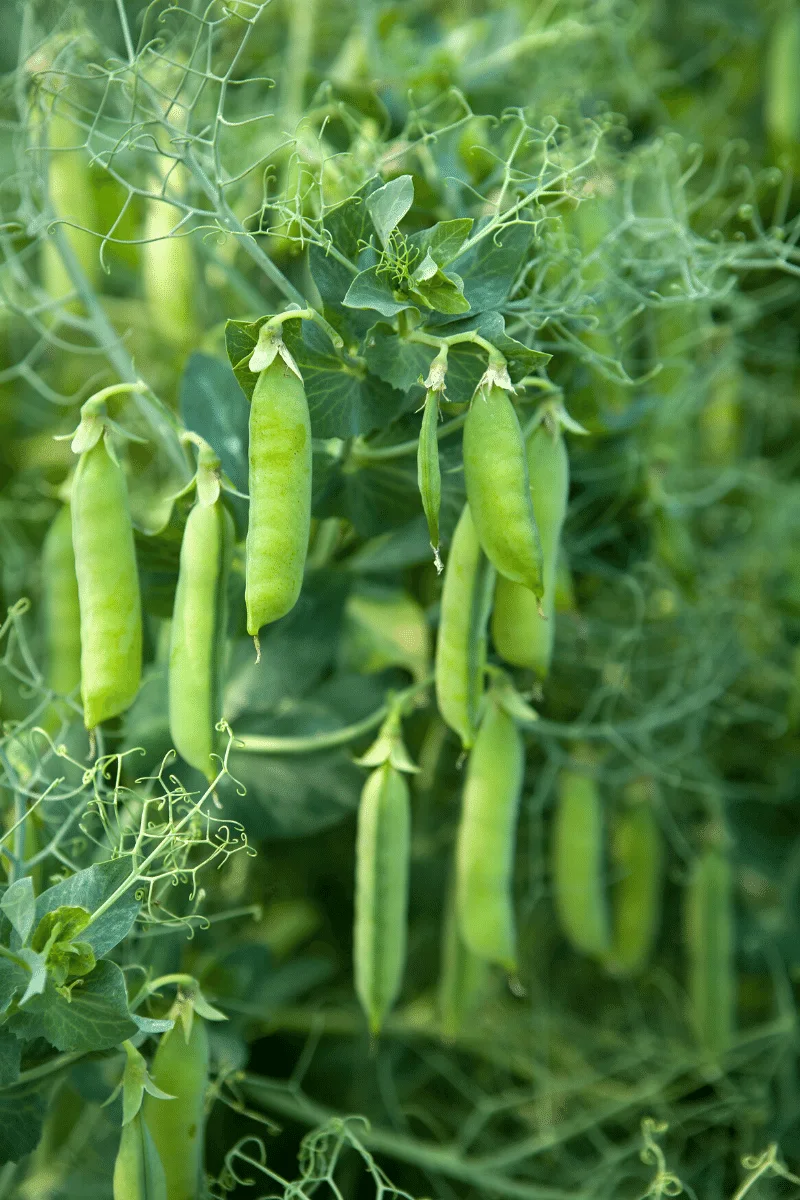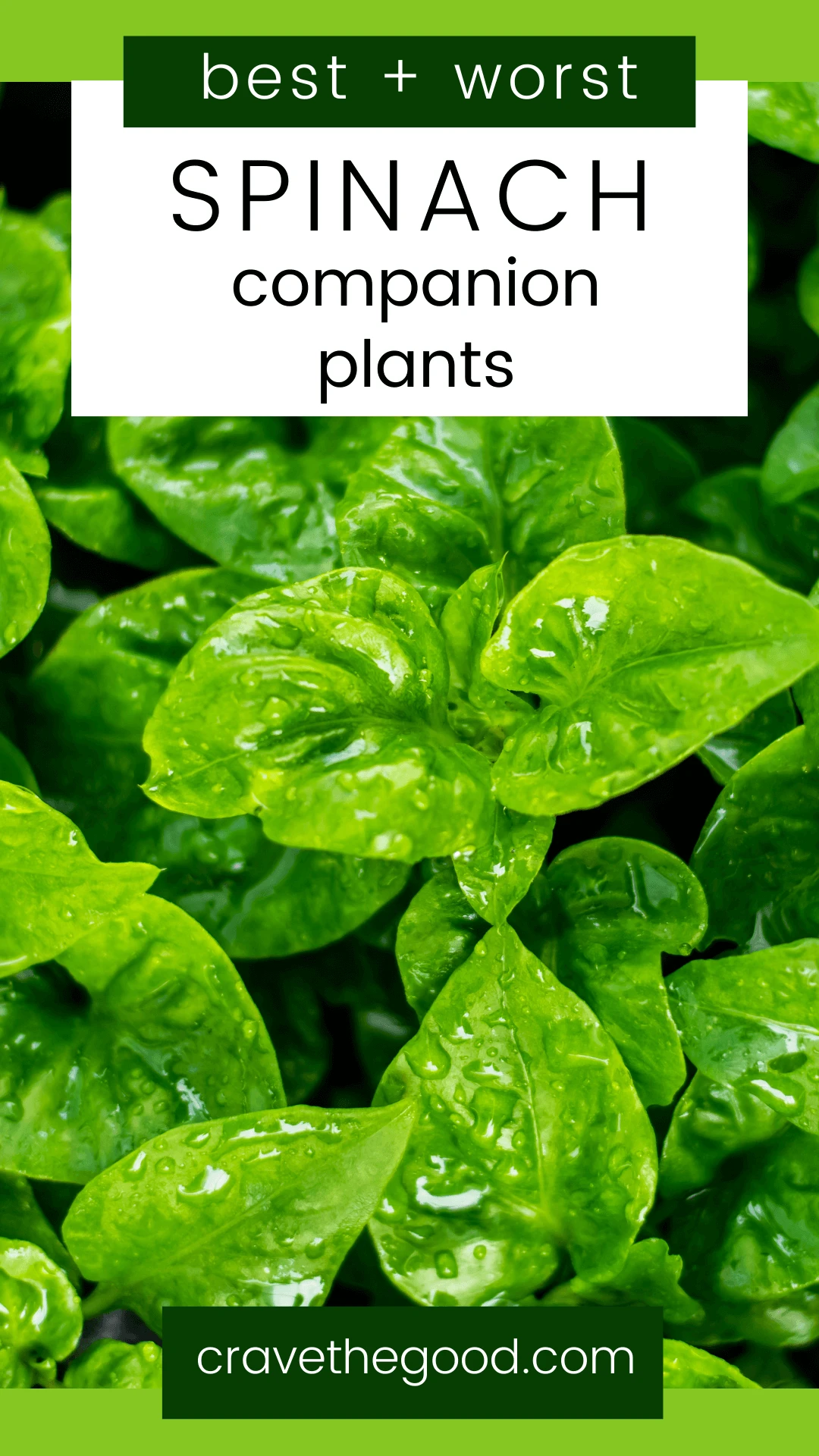If you're looking for companion plants for spinach, look no further! After reading this post, you'll know which plants are beneficial to your spinach and which to avoid!
Spinach is a fast-maturing cool-season crop. It grows best early in the spring and later, near the end of the growing season. Spinach plants are one of the few vegetable crops that can withstand a light frost. They will even continue growing in cold weather as long as the temperature is above freezing.
Spinach grows from a rosette of large, dark-green leaves on upright stems that can reach up to 18 inches tall. Spinach plants have shallow roots, so they do best in loose, fertile soil.
The leaves have a delicate flavor that is slightly sweet and earthy. Spinach leaves are incredibly versatile, they are wonderful in salads, cooked on pizza, and even blended raw into smoothies.

As an Amazon Associate I earn from qualifying purchases.
Jump to:
What Is Companion Planting?
Companion planting is the practice of planting two or more plants together for the benefit of one or both plants. By planting spinach with certain plants, you can help increase the growth of your spinach while also reducing the likelihood of pests and diseases on the spinach leaves, naturally, without any chemicals!
Food forests are basically large-scale companion plantings!
What Are The Benefits?
Companion planting helps to protect plants from pests, foragers, and diseases, without any store-bought chemicals! Some plants attract pollinators or beneficial insects to prey on destructive pests. It can improve the growth and even flavor of one or both plants. Companion plants can help provide optimal growing conditions, such as necessary shade or ground cover. They can also improve soil health through nitrogen fixation and nutrient cycling.
Considerations
- will the plants shade each other or compete for sunlight?
- will the plants attract or deter pests? Are they susceptible to the same pests?
- will they compete for the same space or nutrients?
- will the companion plants interact badly with each other?

Best Companion Plants For Spinach
Alliums
Onions, garlic, and leeks are a spinach gardener's best friends! They all have strong scents that act as natural insect repellants. These fragrant plants are excellent pest deterrents. From destructive insects, like beetles, aphids, and carrot rust fly, to larger foraging pests like rodents and deer.
Alliums also attract beneficial insects, like parasitic wasps and ladybugs. These helpful bugs will eat destructive pests that attack spinach!

Brassicas
Brassicas such as broccoli, cabbage, and cauliflower, brussels sprouts, and more are great companions for spinach. The root systems for both plants are located at different layers in the soil. They don't compete for nutrients and water.
Because we aren't worried that the plants are competing with each other for water and nutrients, we can safely intercrop them amongst each other, saving tons of space and increasing yields.
Radishes are particularly great brassicas to companion with spinach as a trap crop. Their tender greens will help to lure leaf miners away from your spinach, which keeps your spinach leaves edible and shouldn't affect the fast-growing radish roots!

Lettuce:
Lettuce is spinach's best friend! They both have similar growth patterns, and because of this, they are perfect for intercropping. You will get higher yields from planting spinach and lettuce together than if you were to plant them alone in the same space.
These greens can be planted quite close together, and in doing so, they create a ground cover to help keep the soil cooler, and longer. Keeping the soil cool can help to hold the spinach from bolting, or going to seed, just a little bit longer.

Nasturtium
This poor flower is more commonly grown in gardens as a sacrificial crop than for its blooms and edible peppery leaves!
Nasturtium has a pungent smell that attracts aphids away from spinach and onto themselves. They work as a trap crop for spinach! The leaves of spinach are susceptible to aphid infestation, so it's best to companion plant spinach with nasturtium when possible!

Peas
A member of the legume family makes another appearance on the companion plants list! Shocking!
These garden superstars are great to grow near spinach because they help to fix nitrogen in the soil. All legume crops are able to capture nitrogen from the air and convert it to a form that spinach and other plants can use.
This may seem like an insignificant contribution, but think about a freshly fertilized lawn, how lush and green they are, and how fast they grow. Nitrogen helps to boost the health and growth of garden plants it does with lawns!
Bush peas and beans also make a great ground cover for spinach, protecting spinach from soil erosion and keeping the soil cool to prevent bolting.

Strawberries:
A fruit that spinach pairs well with is strawberries! Strawberries are perennial and will return to your garden year after year. Their running, ground covering growth habit helps to keep the soil cool. Cool, moist soil helps to prevent the spinach from bolting too quickly when the weather gets warmer.
Perennial strawberries have deeper more substantial root systems than annual spinach, so these two plants won't be competing for moisture and nutrients in the same soil zone. They also occupy different above-ground growing spaces, eliminating space competition - strawberries are generally short and only a handful of inches tall, while spinach can grow up to 18 inches tall.

Tomatoes:
Tomatoes and peppers, surprisingly enough, are actually great spinach companion plants! They are warm-season crops, so it's safe to interplant spinach between tomato or pepper plants. Tomatoes have a long time to maturity, so they will be in the garden a LOT longer than your spinach, you'll be able to harvest early-season spinach and have it out of the garden long before you're picking vine-ripened tomatoes!
Growing spinach plants in between tomato or pepper plants is a great way to maximize space that would otherwise be wasted for part of the season. As an added bonus, thoughtfully intercropping these plants creates a living mulch/ ground cover to help maintain cooler soils with more moisture.

Worst Companion Plants For Spinach
Fennel:
Fennel is spinach's worst enemy! Ok, to be fair, fennel is everyone's worst enemy. Don't plant fennel anywhere near your food garden.
Fennel is fickle. It's a terrible companion plant for all other food crops (except dill) because it releases negative allopathic chemicals into the soil that inhibit spinach and other plants from growing well.

Potatoes:
Potatoes can be grown near spinach, but they make terrible companions. Potatoes are heavy feeders and can suck up all the nutrients and water in the soil in a hurry! Leaving little or none for your spinach.
Potatoes will also shade out your late-season sowing of spinach when they are at their largest and most bushy.

Final Thoughts
When companion planting spinach, it's important to be mindful of the plants that you choose to grow near it. Some plants make great companions, while others should be avoided.
By planting spinach with other complementary crops, gardeners can increase yields, protect spinach plants from pests, extend the spinach season and maximize garden spaces.
The best spinach companion plants are peas, brassicas, and strawberries. Avoid planting spinach near fennel and potatoes!
Can't Get Enough Companion Planting?
Pin This Spinach Companion Planting Guide!





